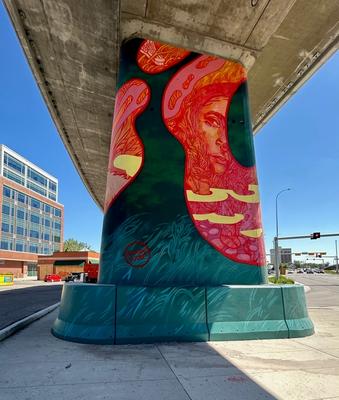Loading name
Loading description
These murals imagine what the land would remember happening in this intersection of 4th Avenue, Edmonton Trail, Reconciliation [Langevin] Bridge and Memorial Drive.

These murals imagine what the land would remember happening in this intersection of 4th avenue, Edmonton Trail, Reconciliation [Langevin] Bridge and Memorial Drive. These memories are drawn as bright warm shapes that hover over the prairie. All the imagery used was drawn from over 200 hours of research and interviews with residents, knowledge keepers, Indigenous elders, archeologists, geologists, historians, local business owners, and randomly encountered unhoused occupants. As viewers look at this artwork, I hope to provoke the question, what memories will we give this piece of land in the years to come?
Historical and Anthropological knowledge: Much of the historical knowledge was provided by Bridgeland resident and knowledge keeper Deb Lee, who supplied writings and photos for my references. My anthropological knowledge is thanks mostly to Blackfoot elder Rod Scout, who connected mewith Blackfoot histories and also edited my design work for cultural sensitivity. Residents and Business Owners: The pasta-making references were inspired by chats with Tony, owner of Villa Firenze, as he shared how as a third generation restaurant owner, he is one of the last of what used to be “Little Italy”. Thanks to Yousef from Bridgeland Market for his time in sharing about the diversity of newcomers, his connection to t he former General Hospital, and the notable characters who are still active in the community. Thanks to Aldina for her Croatian and Italian connection, Shylin for sharing about her Metis heritage in the area. Thanks also to the Calgary Drop In Center for sharing about the underhoused’s long connection to this area. Botanical and Cultural: This project was officially blessed by Blackfoot Spiritual elder Ka'tay'i'ta'toosi Bryan Little Chief from Siksika. The plants referenced in all the images were recommended by him for their medicinal and symbolic properties. They are sage, spruce, wild prairie grass, horsetail, chaga, prairie cactus, juniper, wild rose, yarrow and sweetgrass.
Bison hooves cross over the Bow river, followed by Blackfoot feet, and then by the feet of settlers. The land is symbolized by watchful faces and eyes. A Blackfoot hunter wears a wolf’s skin to approach bison. A prairie fire burns the grasses. Steam rising off hot stones rises up to meet the glacial lake that used to cover this area. Historical meaning: The Blackfoot remember they first learned how to cross the Bow by watching the bison make crossings in this shallow area, and the settlers followed suit. A wooden bridge became the main route from Fort Calgary to Edmonton, later to be replaced by the now-named Reconciliation bridge that we see now. This intersection of the river used to be a prime hunting ground for the Blackfoot people, and thanks to the warm chinook winds, was a winter camping grounds. The eyes and portraits are made of the compiled faces of Arab, Austrian, Chinese, Croatian, English, German, Irish, Indigenous, Italian, Norwegian, Russian, Scottish, Ukrainian, Welsh (among others) people who are living or have lived in Bridgeland.
A European woman drops wheat into the hands of an Italian pasta dough maker. Behind her a raven descends to the prairie. Structures are lowered onto the riverbank by the hands of a laborer during the first days of Bridgland’s formation. A rider sits atop unbroken horses. Children hold the prairie graa and rest. Historical meaning: With the arrival of settlers came new animals, birds, plants and grains. In the early days of becoming an official community, Bridgeland was home to many northern and eastern Europeans, as well as being known as “Little Italy” The structures are some of the Bridgeland’s many churches, the former Calgary General Hospital and Metis cabins. The rider is rancher Tom Threepersons, the winner of the first Calgary Stampede. The hands represent the labor done by the settlers, indigenous and metis people in the early days of Fort Calgary. The children represent the future generations of people who will continue to make their home here. This image looks to the hope of the future, while honoring the labour of those who came before.”
Loading map
Centex on Memorial, two pillars beneath overpass
Last updated: November 13th, 2025